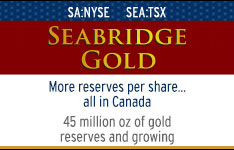What a difference a decade makes! Ten years later, gold had advanced to more than $1000 an ounce—to $1087.50 basis the December 30, 2009 London PM fix—for a gain of roughly 275% over the ten-year period.
Gold—By the Numbers
Gold's steep ascent continued in 2010, finishing the year in New York at $1,420.75. While just shy of its all-time high of $1,432.50 registered on December 7, gold, nevertheless, advanced some 29.5% from the prior year's close and scored its 10th consecutive annual increase.
Despite a rocky start—with prices dipping briefly under $1,360 an ounce on January 7, 2011 promises to be another stellar year as the metal's bullish price drivers continue at full throttle.
I expect the price will very likely rise to the $1,700 level by year-end 2011. This would be a modest gain of only 19% from last year's closing price. And, with the right confluence of events, gold could quite possibly rise to $1,850 or higher by next New Year's Eve.
Over time and across currencies, bull markets in precious metals often last twenty years or more—so we should not be surprised to see the current decade-long advance continue for at least a few more years.
Indeed, I strongly believe gold will surpass $2,000 an ounce in the next few years. . .and I wouldn't be at all surprised to see gold reach $3,000 or higher at the next cyclical peak.
Gold prices are likely to remain volatile, registering big short-term swings both up and down. Although sizable intermittent price declines will lead some to question the bull market's staying power, the long-term trend, as noted above, will remain positive for years to come.
Physical Demand Remains Firm
As we begin the New Year, physical demand in key world gold markets—especially China, India and other Southeast Asian trading centers—has remained remarkably firm despite the record price levels prevailing in recent weeks.
In the past few years, each time gold prices reached for the big round numbers—$900, $1000, $1100, $1,200 and $1300—buying interest diminished and a return flow of price-sensitive old scrap weighed heavily on the market. But now, even with prices once again at or near all-time highs, physical demand remains remarkably strong and only limited quantities of old scrap are coming back to the market.
This suggests not only a continuing price appreciation and revaluation of gold—but also a mental re-evaluation and upward shift in expectations among many gold-market participants about the metal's future price.
If physical buying remains fairly firm—as I believe it will—we can expect that gold will soon advance to new all-time highs.
Bullish Price Drivers
In brief, here are the seven fundamental reasons for gold's long-term rosy outlook:
- Inflation-producing U.S. monetary policies, irrational U.S. fiscal policies, little if any progress reversing growth in Federal debt and a depreciating dollar overseas all promise rising inflation at home. Higher industrial and agricultural prices around the world and across currencies are a harbinger of things to come.
- No quick or easy solution to the Eurozone sovereign risk crisis, a widening economic schism across the continent and possibly the demise of Europe's common currency, the euro, as it exists today.
- China's already huge and growing appetite for gold—both jewelry and investment—will continue in tandem with economic growth, rising personal incomes, worrisome inflation expectations and pro-gold government policies.
- Rising long-term gold demand from India and other traditional Asian gold markets reflecting (as in China) growth in personal incomes and wealth, the maturation of local markets and introduction of new gold investment vehicles and distribution channels.
- Increasing central-bank interest in gold will continue to underpin the market as countries (such as China and Russia) over weighted in U.S. dollar and euro currency reserves and under weighted in gold play catch-up—and as both the dollar and the euro continue to lose their appeal as official reserve assets.
- The continuing reevaluation of gold as a legitimate investment class is prompting greater participation from both retail and institutional investors in the United States and Europe, coupled with new products and channels of distribution (especially the growing popularity of gold exchange traded funds [ETFs] will continue to make gold more convenient, more attractive and more accessible to more investors around the world.
- Little or no growth of aggregate world gold-mine production for at least the next five years—with gold-mining nations absorbing more of their own production to meet domestic demand for jewelry, investment and additions to central bank reserves.
Despite all the rhetoric to the contrary emanating from Washington in the past month or two, Congress and the American people simply are not yet willing to take the tough steps necessary to rein in an out-of-control budget, let alone shrink the country's immense Federal debt.
Just consider the fiscal package passed by Congress and signed by President Obama late last year: Showing no signs of restraint, it guarantees to add some $850 billion, give or take, to the Federal budget deficit—and possibly much more if, as I believe, the underlying assumptions about prospective economic recovery prove overly optimistic.
Where will the money come from if not from higher tax revenues and lower public sector spending? Well, obviously from America's central bank, Washington's financier of last resort, whose policy of quantitative easing is already financing America's out-of-control government spending as it purchases U.S. Treasury debt with newly created money.
This policy is only just beginning to erode the U.S. dollar's purchasing power—an important reflection of which will be rising inflation and a much higher future price of gold.
Had the recent fiscal package included a credible plan for significant long-term deficit reduction, institutional investors and foreign central banks, which have historically funded America's deficit spending, might be more willing to continue taking on more U.S. government debt.
Instead, the growing reluctance of central banks and private investors to pour more good money after bad, to buy more debt that will someday be repaid with cheaper dollars, is already pushing up long-term interest rates in the United States, a trend that will retard the Fed's accommodative policies—and prompt still-more stimulative monetary initiatives as the central bank tries to keep the economy from slumping back into a more painful recession.
Most conventional economists in and out of government see the recent rise in U.S. long-term interest rates through rose-colored eyeglasses—as evidence of a nascent self-sustaining business-cycle recovery. In contrast, I believe this rise in long-term interest rates is the unfortunate consequence of investor and foreign central bank reluctance to accumulate more U.S. Treasury debt unless current yields include a bigger premium to protect against expected future inflation.
Persistent economic weakness and recession-like, if not outright recessionary, business conditions mean that the Federal Reserve will keep the pedal to the metal for some time to come. And, as in the past year, continuing aggressive quantitative easing will push gold prices higher.
The recent retention of the so-called Bush tax cuts and extension of unemployment benefits to millions of long-term idled workers may, in the short run, lift consumer and investor optimism that the recovery is now on a self-sustaining path.
But, this is wishful thinking. A significant increase in Federal budget deficits for years to come will be accompanied by higher long-term interest rates. As a result, much, if not all, of the presumed fiscal stimulus will be offset by higher bond yields even as the Fed monetizes America's rising debt.
Washington's inside-the-beltway economists and most of their private-sector colleagues have not accounted for the economic drag arising from higher yields, drag that will require still-more monetary stimulus from the Federal Reserve.
Optimistic forecasts are also underestimating the effect of state and local government budget problems on the country's overall economic performance. Many of the 50 U.S. states, not allowed by law to run budget deficits, are also entering a year of substantial cuts in public sector employment and wages, social services and grants to local governments and school districts—and substantial increases in income taxes, sales taxes and user fees.
These steps to balance state and municipal budgets will have a significant negative effect on economic activity—not only cutting public spending but also spending by households and businesses to an extent that is not fully accounted for in the more optimistic forecasts of a self-sustaining recovery.
Across the Atlantic—Breaking Up Is Hard to Do
Meanwhile, across the Atlantic, some European countries are slashing government spending so deeply that economic activity will slow or, worse yet, contract, forcing unemployment rates still higher. And, despite spending cuts and higher tax rates, government revenues will fall, blunting the hoped-for reduction in government deficits and perceived sovereign risk.
As a result, rather than improving their creditworthiness, some countries may see their credit ratings marked down still further, forcing the European Central Bank to bail out its most-endangered members yet again by its own program of quantitative easing through the purchase and monetization of member-country sovereign debt.
Meanwhile, the growing disparity between the stronger "core" economies (led by Germany and the Netherlands) and the weaker "peripheral" economies will further threaten the viability of Europe's common currency, the euro, with capital flight and speculative money flowing into both the dollar and gold—contributing over time to the metal's expected appreciation and masking the greenback's inherent weakness.
Recent developments, especially the difficulties of a number of countries to finance their existing deficits and refinance their maturing debt, illustrate the lack of political and social cohesion necessary to maintain a single currency.
What is missing is a shared sense of common statehood. The disparity in inflation rates, fiscal policies, employment markets and economic productivity that separates the poorer peripheral nations from the wealthier core economies is a gap that is proving too wide to bridge with a single currency.
Many of the weaker economies are simply not competitive versus their stronger neighbors. To become more competitive, wages and living standards must fall. . .but electorates will not willingly accept this path. In the old days before a single currency, countries could regain their international competitiveness by depreciating their own currencies—but, in Europe's single-currency regime, this is no longer an option for individual members, all of whom now lack their own currency and exchange-rate policy.
A voluntary reduction in living standards by the populations of the poorer countries is not a politically acceptable social burden. In a few countries it is likely that right-leaning political leaders will be replaced by left-leaning politicians who are unwilling to pursue the extreme austerity programs required by the single-currency system.
The only thing now holding the European single-currency monetary system together is the high cost and seeming impossibility of managing a breakup.
While the euro may survive another year or longer, periodic funding crises will push its exchange rate lower, possibly to parity with the USD in the next few years. Meanwhile, its role as a second-string reserve asset and international numeraire has been irreversibly damaged.
A tarnished euro, periodic funding crises and fears of a euro breakup will benefit gold in the year ahead and beyond—even if the lion's share of scared money and safe-haven demand find shelter in U.S. dollar financial markets.
Chinese Liberalization Promotes Rising Demand
Private gold investment was banned and the market was tightly controlled for more than five decades following the Communist Party takeover in 1949. Ever since the legalization of gold investment and the gradual liberalization of the market beginning in 2002, the Chinese appetite for gold has been growing by leaps and bounds.
Much of the growth in China's gold demand over the past few years has been a result of the government's liberalization of the domestic gold market, its encouragement of private gold investment and the development of new investment vehicles and channels of distribution.
As a result, China has become a powerful driving force in the world gold market, alone accounting for a few hundred dollars in the thousand-dollar price advance in the years since liberalization.
China's gold investment demand rose by roughly 75% last year to an estimated 170 tons while gold jewelry purchases rose by some ten% or so to 380 tons—putting total consumption in 2010 around 550 tons. While the country has seen a significant rise in domestic mine production, so much so that it is now the world's biggest gold-mining nation, imports are necessarily rising to fill the supply-demand gap. China's legal and illegal gold imports may have totaled as much as 250 tons last year—giving the country an increasingly important price-setting role in the world gold market.
These trends are likely to continue, if not accelerate, in the next few years reflecting demographics, strong economic growth, rising personal incomes, worrisome inflation and the continuing development and maturation of the gold-market infrastructure.
China's first gold exchange-traded fund (a hybrid that invests in overseas gold ETFs) was launched this past December and was quickly fully subscribed. I anticipate several other gold ETFs (or similar exchange-traded products) will be launched this year giving Chinese investors—both households and institutions—greater access and choice. I suspect Chinese-listed gold ETFs will grow rapidly in the next few years, just as they have in the West, possibly with a profound effect on the world market and the U.S. dollar gold price.
China—Continuing Growth Despite Monetary Tightening
The recent and prospective monetary tightening by China's central bank, the People's Bank of China (the PBOC), will not diminish the country's growing appetite for gold jewelry and investment.
PBOC policy actions—raising interest rates and some bank reserve requirements—are in response to super-strong economic activity and accelerating domestic price inflation. But, real interest rates (after adjustment for inflation) are actually falling. . .and have become more stimulative and supportive of gold. Moreover, Chinese monetary authorities would like to see more, not less, private gold investment.
At most, Chinese authorities are trying to cool a hot economy and slow the annual rate of GDP growth from around 10% to a more sustainable pace around 7%. I have long argued that the country's long-term bullish influence on the world gold market would continue as long as China's economy continues to chug along at a moderate rate with or without worrisome rates of consumer price inflation.
If inflation accelerates, as it has recently, led by rising food and commodity prices, that's just icing on the cake, boosting gold demand still more.
While news of monetary tightening by the People's Bank of China may occasionally trigger brief short-lived reductions in gold purchases, China's gold demand is likely register strong growth this year and beyond. . .and is likely to have a powerful influence on the future price of gold.
Indian Demand Heats Up
India's appetite for gold is once again hot as curry. As in China, economic growth has been strong with GDP up smartly last year—and inflation has been showing signs of heating up too. Good summer monsoons brought healthy autumn harvests. . .and, as a result, income to the agrarian sector has been the best in years. Importantly, the agrarian sector accounts for a lion's share of the country's gold consumption.
Imports of gold surged during the third quarter, so much so that total 2010 imports could reach 800 tons or more, up from 595 tons last year—putting India, for now, far above China as the biggest gold-consuming nation.
India has historically been a very price-sensitive market. Typically, buying interest falls off as prices rise; and, at higher prices, India women are known to take profits, cashing in their bangles and chains, so much so that Indian gold scrap can be an important short-term source of supply to the world market.
In the past, Indian gold buying and reselling often locked the U.S. dollar price of gold into trading ranges with low prices triggering more buying and higher prices triggering more selling.
In contrast, we are now seeing much less price sensitivity of demand. Even at recently prevailing prices around $1,400 an ounce, Indians now seem eager to continue buying—suggesting a psychological reevaluation of gold's future price prospects.
As in China, Indian gold investment is being securitized by the growth in gold ETFs. First introduced in 2007, there are now 10 gold ETFs with physical gold held on behalf of investors totaling more than half a million ounces (about 15.5 tons)—and holdings could easily double this year as more mainstream stock market investors participate.
Central Banks Buying More
After net sales of roughly 400 to 500 tons a year over the prior decade, the official sector (central banks, the International Monetary Fund and sovereign wealth funds) became a net buyer of gold in 2009. Last year, net official purchases continued as a number of central banks, principally in Asia, added to their official reserves while sales by European central banks continued to diminish.
Net official purchases may have totaled as much as 100–200 tons in each of the past two years, even allowing for the IMF's 403-ton gold sales program.
I don't believe the officially published data on central bank gold transactions. . .and data on sovereign wealth fund investments in gold are, for the most part, unreported. So, it's not possible to get an exact reckoning of net annual purchases or sales by the official sector. In short, we don't know what we don't know when it comes to central bank gold purchases.
That said, central banks are continuing to buy gold for additions to official reserves. China, for example, announced last April that its central bank had purchased 454 tons in the prior six years—but chose not to report these purchases until more recently. Many observers, myself included, believe that China continues to buy significant quantities on a regular basis, some if not all from domestic mine production.
Saudi Arabia also added significant quantities of gold—180 tons, in fact—to its official holdings over the past few years—but did not report these purchases until this past June. It is likely that the Saudi Arabia Monetary Authority also continues to buy, along with some of the other oil producers with dollar-heavy, gold-underweighted official reserves.
What we do know is that the list of countries that have bought gold beginning in 2009 continues to grow. Some of the names on this list include Russia, Kazakhstan, India, Sri Lanka, Mauritius, Venezuela, the Philippines, Thailand and even Bangladesh. And, South Korea recently announced it is considering adding to its official reserves.
We also know that the IMF gold sales program, which commenced in 2009 and promised to sell 403.3 tons, has already run its course. One must wonder how the market will react now that the IMF is no longer supplying gold to the market.
Jeffrey Nichols
NICHOLSonGOLD
2011: Another Banner Year for Gold


























































